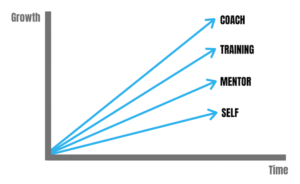How Steep is Your Growth Curve?
“Knowledge alone is not enough. You need to put what you learn into practice, or you’re no further ahead.” - Kevin Lawrence, Your Oxygen Mask First
When I was in New Delhi, India, recently, doing 360 feedback and coaching for key executives, a question came up about how to increase the growth curve when developing future leaders. How could we take the natural growth curve and make it steeper?
Like using new equipment for the first time, you’ll eventually figure it out, through trial and error.
If a manager teaches you, you’ll learn faster. The learning curve starts to rise.
 In a full training program, you learn even more, and the curve gets steeper. And, ultimately, with a coach to guide you, as you take and test what you’ve learned in the real world, the curve can go off the charts.
In a full training program, you learn even more, and the curve gets steeper. And, ultimately, with a coach to guide you, as you take and test what you’ve learned in the real world, the curve can go off the charts.
Without the combination of these investments, they could still be fiddling with the knobs.
“Invest the energy it takes to stay ahead of the game.”
Now, the return can still be zero even if you do natural and formal learning, and work with a manager and a coach unless you have the discipline to apply it on a daily basis.
We all know this. We’ve seen it as we help our children to learn new skills, like riding a bike or learning a sport. But, once they get going and we see them doing decently well, we often forget to keep helping them to grow further because we all get so busy doing our work.
There’s no limit to how much motivated people can grow, with the right support and in an environment where they have the ability to be great.
The Challenge
- Are you truly making investments consistent with the growth you want to see in your team?
If you want to learn more about our Leadership Education program, training, workshops and coaching, please get in touch.
Listen to Your Body...Before Your Hands Turn Blue
“The uneasy truth is that you can handle a great amount stress until, suddenly, you can’t.” - Kevin Lawrence
I put a lot of effort into presenting a simplified version of the principles in my book, in Montreal, because I want to make a greater impact on audiences about how the 17 habits can help to manage their energy, clarity, team and growth. It’s important for people to get that, at the end of the day, leadership is a mental game.
After the keynote, many shared their stores about how the content resonated and was meaningful, to them. Two stories stuck out:
- One was from someone who had lost their spouse, a few years ago, to mental health issues which led to a medical condition that ended his life prematurely. It had been a painful experience, but she had come out notably stronger because she had seen a therapist and done the work. This is a great example of what I talk about in Chapter 6 Deal with Your Emotional Junk. By doing the necessary work, these challenging and traumatic events can be an addition to our lives, rather than a permanent trauma.
- Like many very successful people, another CEO said she would just keep pushing through when she met an obstacle or an issue, ignoring her body’s signs to get her attention to stop. One day, she got a big wake-up call when she noticed her hands were blue - yes, literally blue, like the characters in Avatar - and found out that her body had gone into a shock-like state, emulating a condition in the body where the blood drains out of a part that is threatened. Like in caveman days, when a person was bitten by an animal and the body responded to make sure they didn’t bleed out. She also had Bell’s Palsy, a condition in which the muscles on one side of your face become temporarily weak or paralyzed.
This was one of the craziest stories I’ve heard, but I’ve seen similar things with high-performing leaders. Sooner or later, strong, smart, determined people who just keep pushing through are stopped in their tracks – and it can be spectacularly dramatic when it happens.
The Challenge
- Listen to your body. What are the signals your body gives you when you are stressed?
- What do you need to do about it?
Burning Out and Fading Away
Everyone suffers, sooner or later, in a way that effects their performance.
How do you live your passion? How do you have great success and a great life?
Why do some high achievers thrive, while others burn out or fade away?
I’ve always been fascinated by how some people can sustain the excitement and pain of growing a company or a career – and others burn out or fade away. In fact, it’s been the inspiration behind my coaching practice and my book Your Oxygen Mask First.
Over the last couple of years, as I’ve been speaking about the principles in my book, gaining insights from my clients, and doing research with thousands of leaders – one-on-one, and in polls at keynotes and workshops – I’ve learned that there’s a better question because essentially every high-performing leader of a high-growth company burns out along the way.
No-one escapes the pains of growth – and they don’t necessarily talk about it because of perceived weakness and shame. After all, burnout seems the opposite of what happens to strong, bold alpha leaders. But, in one way or another, in some shape or form, I’ve learned that it happens to all of us. Some recover, some come out twice as strong, some are destroyed.
It’s just part of the game. What matters is how you handle it.
So, the new question is:
How do you keep thriving knowing you will burn out and ensure you never fade away?
The Challenge
I’d like to collect more stories about how people have experienced burn out and who have come back stronger.
Do you have a story to tell or know someone who has a good story that others should hear?
PS If you are feeling in a rough spot, at the moment…
- Resilience Rituals are a great place to start to get stronger
- If you are really in a bad place and don’t know where to turn, reach out to us, a doctor or a psychologist. Asking for help is a good thing.
Long Term Vision: The Built-to-Last Chair Test
Built-to-last, long-term thinking has the biggest impact, over time.
In early September, I had a chance to tour the Notre Dame Campus in South Bend, Indiana, and wow, was it a great experience!
The history was fascinating, the campus was stunning, the stadium mind-blowing. Imagine 80,000 people in a college football stadium - incomprehensible from a Canadian perspective.
 What struck me most was how everything was built to last – right down to the chairs in their campus eateries. Our tour guide explained that these chairs are just one small example of the founders’ long-term vision to build an enduring organization.
What struck me most was how everything was built to last – right down to the chairs in their campus eateries. Our tour guide explained that these chairs are just one small example of the founders’ long-term vision to build an enduring organization.
These chairs have already been there for 80 years and were designed to last at least 100. At the time, samples of different styles were brought in and then thrown down the stair wells. The ones that withstood the beating were the ones they bought. Sounds like a fun experiment! I’d love to see how some of our furniture today stands that test!
There are hundreds of examples of what Notre Dame U. leadership has done to make sure they built an enduring legacy: the stands they took to make sure things happened, and the sacrifices they made. That long-term thinking has a big impact on culture - a sense of pride that infuses and inspires people to continue their vision, long after the founders are gone.
The whole experience made me think about what leaders can do, in this world of rapid change. While there’s always a need to innovate quickly and focus on short-term results, built-to-last, long-term thinking has the biggest impact, over time.
The Challenge
- What, in your business, needs a ‘chair test’ to make sure it works in the very, very long term?
- What currently fails your version of a ‘chair test’ that you need to change?
Positive Performance Pressure
“An ounce of practice is worth more than a ton of preaching.” - Mahatma Gandhi
We often talk about how people are our greatest asset - how investing in them and helping them to grow is important. But I rarely hear people talk about how we need to put people into situations where they need to perform; where they can use their capabilities and leverage their practice to create incredible results.
I think of this often when I look at teams that don’t perform as well as they could because they have leader who lets them off the hook, or who doesn’t create enough positive performance pressure.
I call this the power of having to perform.
We know this from the world of sport.
You start with great people and an incredible amount of practice. Then there’s a game with an objective, and everyone brings an incredible amount of their best energy and focus to create their best performance possible. The team rallies to work together for a short period when they are very productive, tested and challenged, and don’t waste a second.
This is not how we normally operate in business.
We start with good people and spend some time training, but we don’t have a positive pressure performance time – a time when we really need to drive hard to perform and shine. Sometimes a sales team does, or finance team at month end, but I think there an opportunity to do more – especially in companies that are founder- or family-owned.
One Story
This difference was best described by an executive in a family-owned business, during a break at a retreat:
“What I love about this family business is that when things don’t go well, or when we have a bad month, it’s not a big deal. We’re disappointed but no one leaves stressed out or in tears. We just try to do better, next time.
“In the company I came from, if we were off our profit, there would be incredible intensity and preparation before the board meeting to make sure we knew exactly what happened, and to get it back in a matter of days.
“But you know what? There’s a part of me that loved being in that environment. It forced us to perform and find ways to win. We got very creative and yes, we had some late meetings and sleepless nights but, at the end of the day, we always found a way to make it happen because we had to. There was no way we were going to show up at that board meeting without understanding and answers.
“it just wouldn’t be tolerated.”
I asked this executive if she had more tension to perform, now, could her company perform better?
“Heck ya! We could perform way better because we’d just have to.”
The Opportunity to Be Better
At the end of the day, you can take a group of human beings and if some have to perform better, and some don’t, the have-tos will rise to the occasion almost every time, because that’s how we’re wired.
Leaders who think they are being nice and overly understanding are really setting up their people and their environment to be mediocre. But it’s important to never forget that, when tested, the human spirit shows incredible survival instincts and creativity.
That provides great potential for family- and founder-run businesses to find the middle ground – to create tension through positive pressure and opportunities to perform that bring out the best of their people and keep their real heart and soul.
The Challenge
Think about your business and team:
- Are you more about letting people off the hook, and into comfort and mediocrity? Or
- Are you holding the bar high, creating an environment and the support to challenge them? To find ways to make things happen, with budget and time constraints, so that creativity can kick in?
- How can you create more Positive Performance Pressure so can your team find ways to win because they have to?
Setting Expectations - The Always and Never List
“Tell people what to expect and hold them to it without apology.” - Your Oxygen Mask First
I often talk to people about one of the things key principles from Chapter 13 of my book – Teach People to Meet Your Standards - called the Always and Never list. It’s a mini instruction manual about setting expectations and what people need to do to work well with you.
As a leader, you need to be comfortable saying exactly what’s on your mind and to get your expectations on the table. The best people want to work with you effectively, but they won’t know how to unless you tell them. It’s not rocket science. If you want people to do their best job possible, you have to teach them to meet your standards, without surprises or guess work.
Otherwise, they start to make stuff up – and often miss the mark and get it wrong. We get too busy to say anything and get used to people disappointing us. That’s not fair to anyone.
One CEO I worked with hated emails but because they are part of the normal culture, he didn’t say anything - and everyone emailed him. I only found out when he pointed out that he loved working with one particular executive. When I asked him why he said it was because he never emailed him. He just sent him updates on WhatsApp and worked with him on the fly. He loved it!
When I pressed, he admitted that he’d never asked others to do the same. So, one by one, we educated his team. The CEO was happy and the team loved it because decisions were made faster.
In my world there are six things on my Always and Never list:
- The 24/7 rule – If we talk about a task or a project to get done, I expect the task to be completed in 24 hours and the project, in seven days.
- Be on time – A face-to-face meeting means arriving 10 minutes early, ready to go when the clock strikes the hour
- When speaking – don’t start with the back story of a land far, far away. Give me the headlines, then back it up
- Emails – Never expect that your job is finished just because you’ve sent me an email. Arrange a time to review and talk. Conversely, when I send you an email, I assume you’ve got it – you don’t need to reply that you have.
- Never make excuses and pass blame - Screwing up is OK but don’t slough off responsibility.
- Don’t make me ask twice.
The Challenge
- Draft your Always and Never List with five or six things you wish everyone on your team would always do or never do when working with you
- Share it with people on your team
- Ask them to draft and share their lists with you and with each other.





